Classroom Language Assessment: Design and Application Principles
VerifiedAdded on 2023/06/04
|10
|2828
|311
Report
AI Summary
This report provides a detailed analysis of language assessment design and its application within various teaching contexts. It explores the fundamental principles of language assessment, including practicality, reliability, validity, authenticity, and washback, and how these principles can be applied in designing effective assessments. The report also examines different language assessment tools and techniques such as standardized assessments, self-report measures, observation, language sampling, and curriculum-based assessment, evaluating their applicability in classroom settings. Specifically, it focuses on intensive and selective listening tasks, as well as responsive and interactive speaking tasks. Furthermore, the report critically evaluates the author's own classroom language assessment practices in comparison to others, emphasizing the importance of validity and washback in ensuring reliable and practical learning outcomes. The assessment discussion concludes that the designed assessment effectively meets the criteria of language assessment principles, providing a practical and valid approach to evaluating language skills.
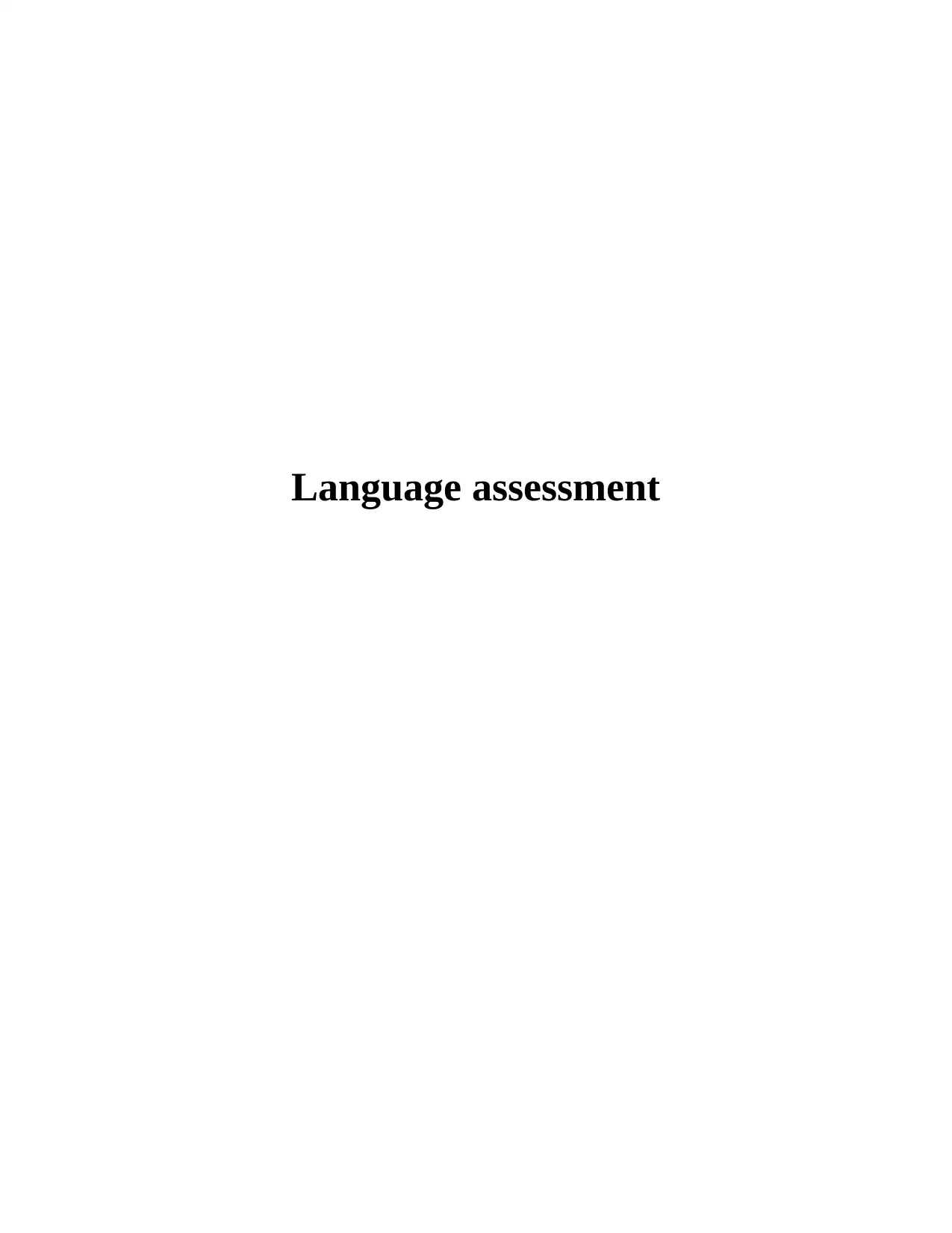
Language assessment
Paraphrase This Document
Need a fresh take? Get an instant paraphrase of this document with our AI Paraphraser
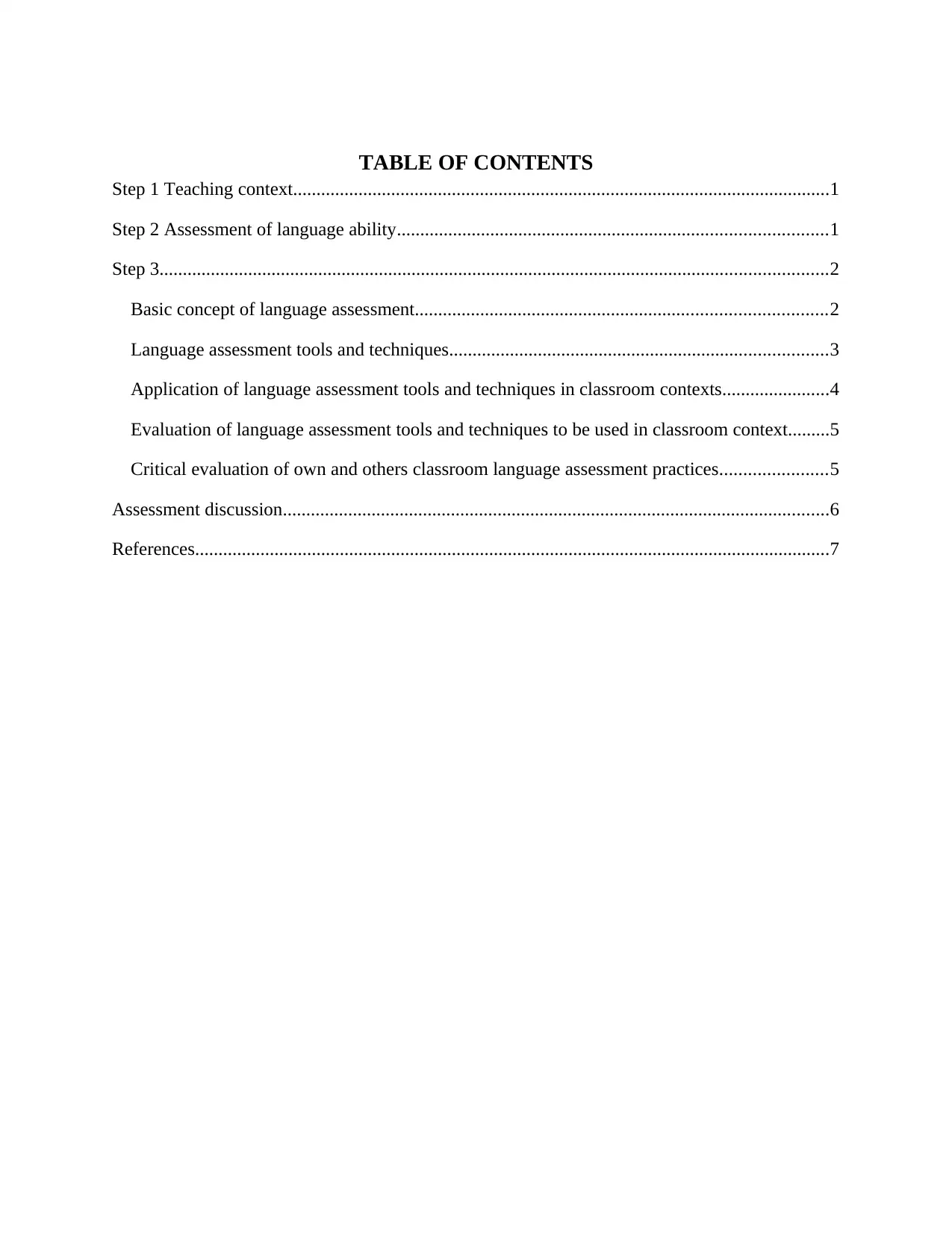
TABLE OF CONTENTS
Step 1 Teaching context...................................................................................................................1
Step 2 Assessment of language ability............................................................................................1
Step 3...............................................................................................................................................2
Basic concept of language assessment........................................................................................2
Language assessment tools and techniques.................................................................................3
Application of language assessment tools and techniques in classroom contexts.......................4
Evaluation of language assessment tools and techniques to be used in classroom context.........5
Critical evaluation of own and others classroom language assessment practices.......................5
Assessment discussion.....................................................................................................................6
References........................................................................................................................................7
Step 1 Teaching context...................................................................................................................1
Step 2 Assessment of language ability............................................................................................1
Step 3...............................................................................................................................................2
Basic concept of language assessment........................................................................................2
Language assessment tools and techniques.................................................................................3
Application of language assessment tools and techniques in classroom contexts.......................4
Evaluation of language assessment tools and techniques to be used in classroom context.........5
Critical evaluation of own and others classroom language assessment practices.......................5
Assessment discussion.....................................................................................................................6
References........................................................................................................................................7
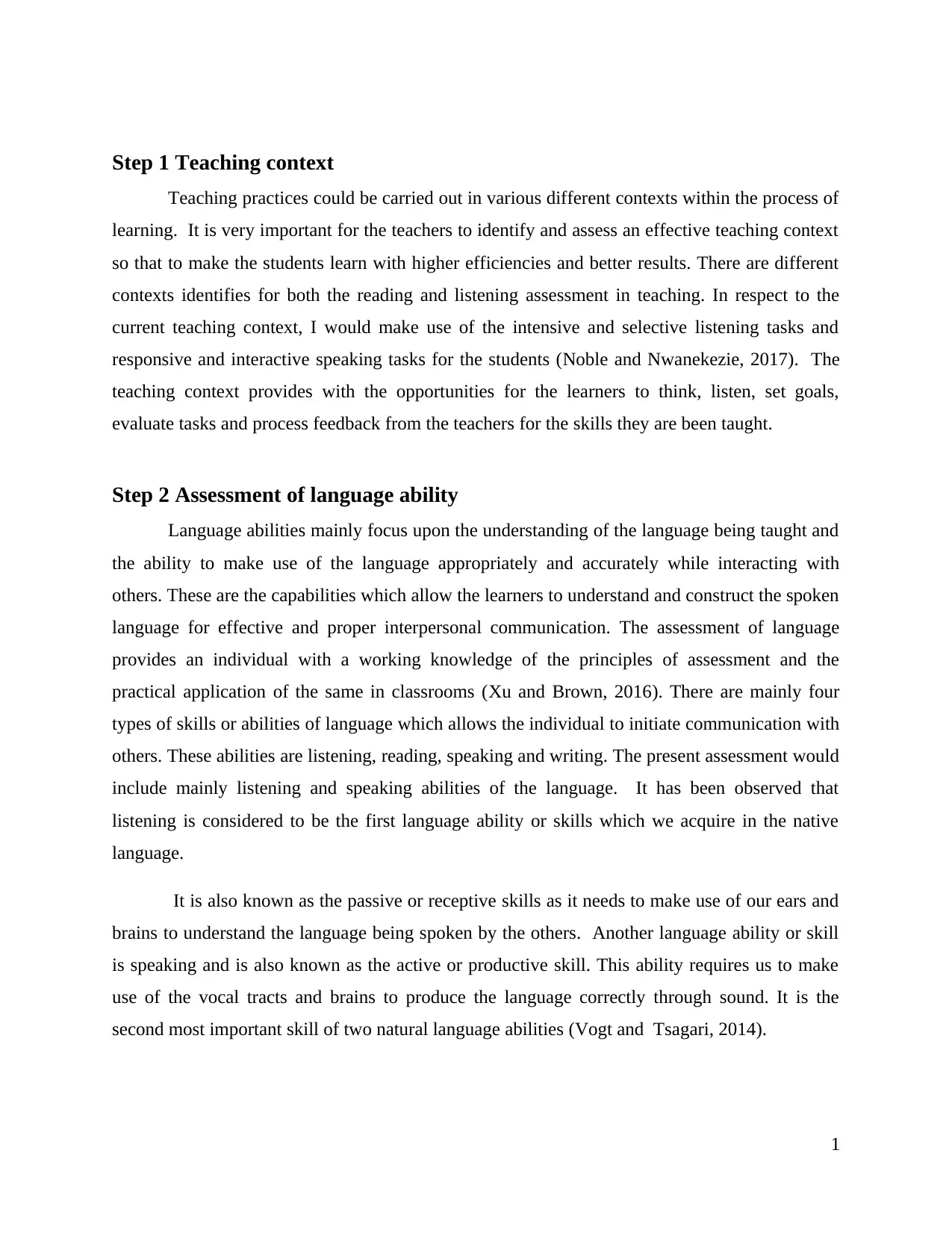
Step 1 Teaching context
Teaching practices could be carried out in various different contexts within the process of
learning. It is very important for the teachers to identify and assess an effective teaching context
so that to make the students learn with higher efficiencies and better results. There are different
contexts identifies for both the reading and listening assessment in teaching. In respect to the
current teaching context, I would make use of the intensive and selective listening tasks and
responsive and interactive speaking tasks for the students (Noble and Nwanekezie, 2017). The
teaching context provides with the opportunities for the learners to think, listen, set goals,
evaluate tasks and process feedback from the teachers for the skills they are been taught.
Step 2 Assessment of language ability
Language abilities mainly focus upon the understanding of the language being taught and
the ability to make use of the language appropriately and accurately while interacting with
others. These are the capabilities which allow the learners to understand and construct the spoken
language for effective and proper interpersonal communication. The assessment of language
provides an individual with a working knowledge of the principles of assessment and the
practical application of the same in classrooms (Xu and Brown, 2016). There are mainly four
types of skills or abilities of language which allows the individual to initiate communication with
others. These abilities are listening, reading, speaking and writing. The present assessment would
include mainly listening and speaking abilities of the language. It has been observed that
listening is considered to be the first language ability or skills which we acquire in the native
language.
It is also known as the passive or receptive skills as it needs to make use of our ears and
brains to understand the language being spoken by the others. Another language ability or skill
is speaking and is also known as the active or productive skill. This ability requires us to make
use of the vocal tracts and brains to produce the language correctly through sound. It is the
second most important skill of two natural language abilities (Vogt and Tsagari, 2014).
1
Teaching practices could be carried out in various different contexts within the process of
learning. It is very important for the teachers to identify and assess an effective teaching context
so that to make the students learn with higher efficiencies and better results. There are different
contexts identifies for both the reading and listening assessment in teaching. In respect to the
current teaching context, I would make use of the intensive and selective listening tasks and
responsive and interactive speaking tasks for the students (Noble and Nwanekezie, 2017). The
teaching context provides with the opportunities for the learners to think, listen, set goals,
evaluate tasks and process feedback from the teachers for the skills they are been taught.
Step 2 Assessment of language ability
Language abilities mainly focus upon the understanding of the language being taught and
the ability to make use of the language appropriately and accurately while interacting with
others. These are the capabilities which allow the learners to understand and construct the spoken
language for effective and proper interpersonal communication. The assessment of language
provides an individual with a working knowledge of the principles of assessment and the
practical application of the same in classrooms (Xu and Brown, 2016). There are mainly four
types of skills or abilities of language which allows the individual to initiate communication with
others. These abilities are listening, reading, speaking and writing. The present assessment would
include mainly listening and speaking abilities of the language. It has been observed that
listening is considered to be the first language ability or skills which we acquire in the native
language.
It is also known as the passive or receptive skills as it needs to make use of our ears and
brains to understand the language being spoken by the others. Another language ability or skill
is speaking and is also known as the active or productive skill. This ability requires us to make
use of the vocal tracts and brains to produce the language correctly through sound. It is the
second most important skill of two natural language abilities (Vogt and Tsagari, 2014).
1
⊘ This is a preview!⊘
Do you want full access?
Subscribe today to unlock all pages.

Trusted by 1+ million students worldwide
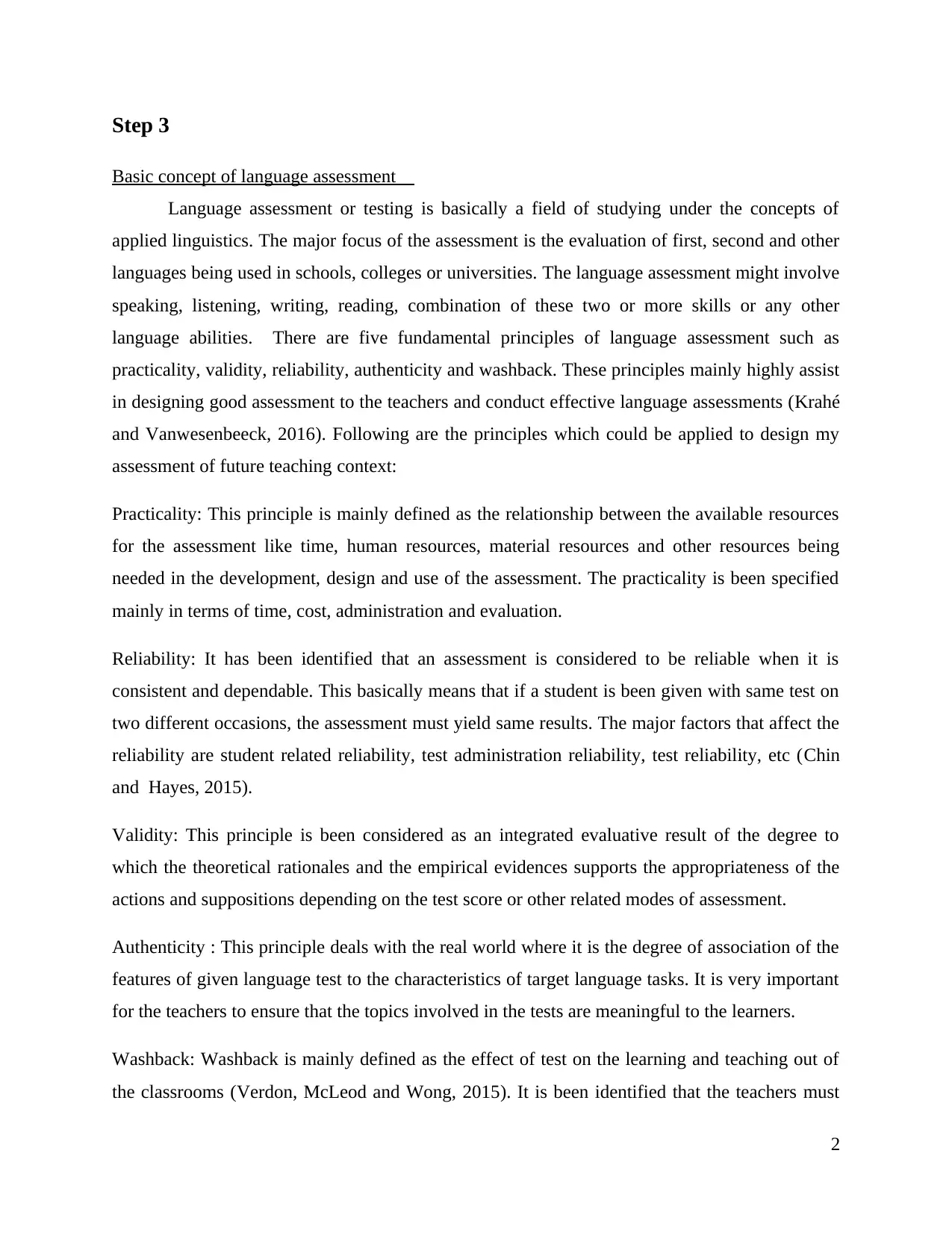
Step 3
Basic concept of language assessment
Language assessment or testing is basically a field of studying under the concepts of
applied linguistics. The major focus of the assessment is the evaluation of first, second and other
languages being used in schools, colleges or universities. The language assessment might involve
speaking, listening, writing, reading, combination of these two or more skills or any other
language abilities. There are five fundamental principles of language assessment such as
practicality, validity, reliability, authenticity and washback. These principles mainly highly assist
in designing good assessment to the teachers and conduct effective language assessments (Krahé
and Vanwesenbeeck, 2016). Following are the principles which could be applied to design my
assessment of future teaching context:
Practicality: This principle is mainly defined as the relationship between the available resources
for the assessment like time, human resources, material resources and other resources being
needed in the development, design and use of the assessment. The practicality is been specified
mainly in terms of time, cost, administration and evaluation.
Reliability: It has been identified that an assessment is considered to be reliable when it is
consistent and dependable. This basically means that if a student is been given with same test on
two different occasions, the assessment must yield same results. The major factors that affect the
reliability are student related reliability, test administration reliability, test reliability, etc (Chin
and Hayes, 2015).
Validity: This principle is been considered as an integrated evaluative result of the degree to
which the theoretical rationales and the empirical evidences supports the appropriateness of the
actions and suppositions depending on the test score or other related modes of assessment.
Authenticity : This principle deals with the real world where it is the degree of association of the
features of given language test to the characteristics of target language tasks. It is very important
for the teachers to ensure that the topics involved in the tests are meaningful to the learners.
Washback: Washback is mainly defined as the effect of test on the learning and teaching out of
the classrooms (Verdon, McLeod and Wong, 2015). It is been identified that the teachers must
2
Basic concept of language assessment
Language assessment or testing is basically a field of studying under the concepts of
applied linguistics. The major focus of the assessment is the evaluation of first, second and other
languages being used in schools, colleges or universities. The language assessment might involve
speaking, listening, writing, reading, combination of these two or more skills or any other
language abilities. There are five fundamental principles of language assessment such as
practicality, validity, reliability, authenticity and washback. These principles mainly highly assist
in designing good assessment to the teachers and conduct effective language assessments (Krahé
and Vanwesenbeeck, 2016). Following are the principles which could be applied to design my
assessment of future teaching context:
Practicality: This principle is mainly defined as the relationship between the available resources
for the assessment like time, human resources, material resources and other resources being
needed in the development, design and use of the assessment. The practicality is been specified
mainly in terms of time, cost, administration and evaluation.
Reliability: It has been identified that an assessment is considered to be reliable when it is
consistent and dependable. This basically means that if a student is been given with same test on
two different occasions, the assessment must yield same results. The major factors that affect the
reliability are student related reliability, test administration reliability, test reliability, etc (Chin
and Hayes, 2015).
Validity: This principle is been considered as an integrated evaluative result of the degree to
which the theoretical rationales and the empirical evidences supports the appropriateness of the
actions and suppositions depending on the test score or other related modes of assessment.
Authenticity : This principle deals with the real world where it is the degree of association of the
features of given language test to the characteristics of target language tasks. It is very important
for the teachers to ensure that the topics involved in the tests are meaningful to the learners.
Washback: Washback is mainly defined as the effect of test on the learning and teaching out of
the classrooms (Verdon, McLeod and Wong, 2015). It is been identified that the teachers must
2
Paraphrase This Document
Need a fresh take? Get an instant paraphrase of this document with our AI Paraphraser
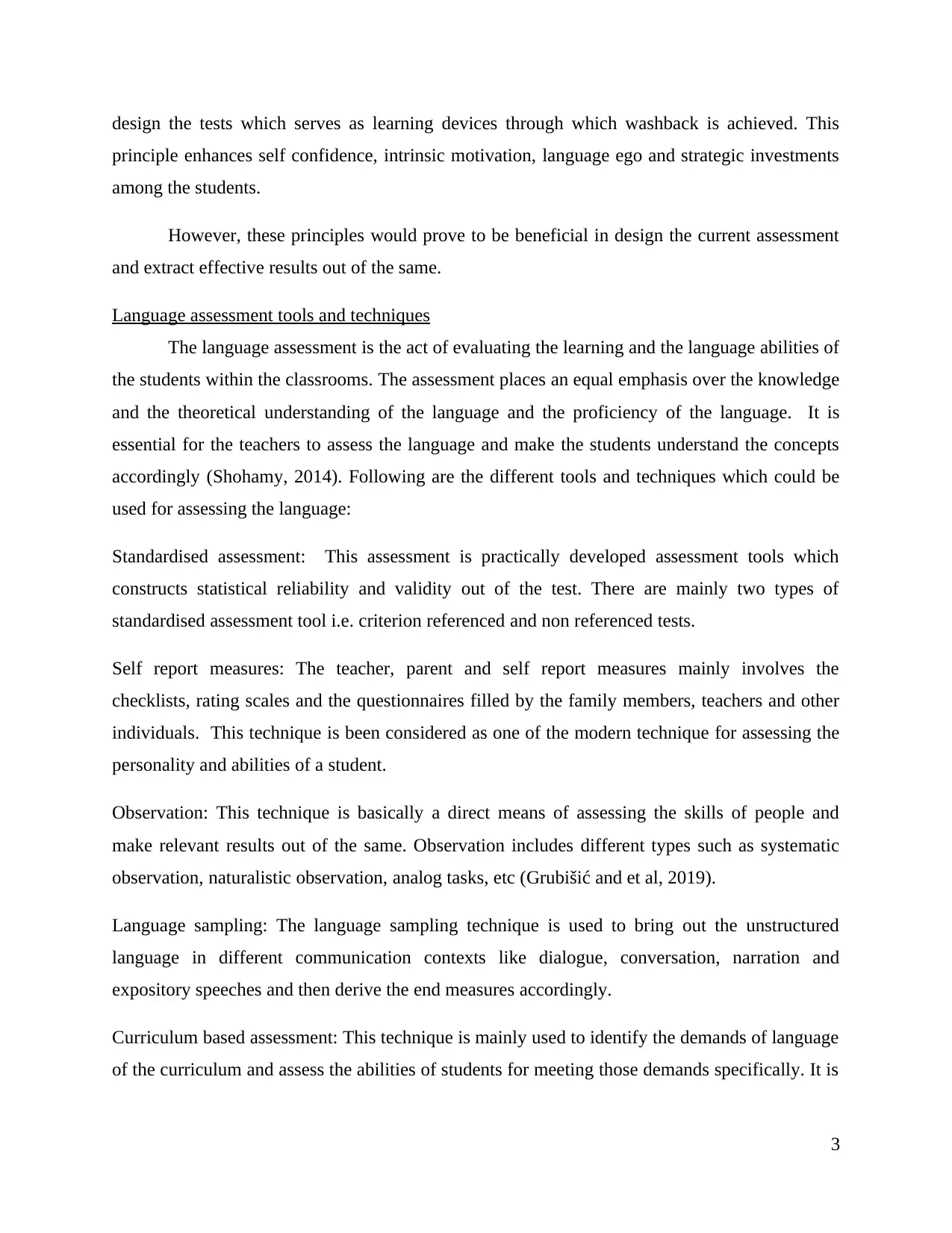
design the tests which serves as learning devices through which washback is achieved. This
principle enhances self confidence, intrinsic motivation, language ego and strategic investments
among the students.
However, these principles would prove to be beneficial in design the current assessment
and extract effective results out of the same.
Language assessment tools and techniques
The language assessment is the act of evaluating the learning and the language abilities of
the students within the classrooms. The assessment places an equal emphasis over the knowledge
and the theoretical understanding of the language and the proficiency of the language. It is
essential for the teachers to assess the language and make the students understand the concepts
accordingly (Shohamy, 2014). Following are the different tools and techniques which could be
used for assessing the language:
Standardised assessment: This assessment is practically developed assessment tools which
constructs statistical reliability and validity out of the test. There are mainly two types of
standardised assessment tool i.e. criterion referenced and non referenced tests.
Self report measures: The teacher, parent and self report measures mainly involves the
checklists, rating scales and the questionnaires filled by the family members, teachers and other
individuals. This technique is been considered as one of the modern technique for assessing the
personality and abilities of a student.
Observation: This technique is basically a direct means of assessing the skills of people and
make relevant results out of the same. Observation includes different types such as systematic
observation, naturalistic observation, analog tasks, etc (Grubišić and et al, 2019).
Language sampling: The language sampling technique is used to bring out the unstructured
language in different communication contexts like dialogue, conversation, narration and
expository speeches and then derive the end measures accordingly.
Curriculum based assessment: This technique is mainly used to identify the demands of language
of the curriculum and assess the abilities of students for meeting those demands specifically. It is
3
principle enhances self confidence, intrinsic motivation, language ego and strategic investments
among the students.
However, these principles would prove to be beneficial in design the current assessment
and extract effective results out of the same.
Language assessment tools and techniques
The language assessment is the act of evaluating the learning and the language abilities of
the students within the classrooms. The assessment places an equal emphasis over the knowledge
and the theoretical understanding of the language and the proficiency of the language. It is
essential for the teachers to assess the language and make the students understand the concepts
accordingly (Shohamy, 2014). Following are the different tools and techniques which could be
used for assessing the language:
Standardised assessment: This assessment is practically developed assessment tools which
constructs statistical reliability and validity out of the test. There are mainly two types of
standardised assessment tool i.e. criterion referenced and non referenced tests.
Self report measures: The teacher, parent and self report measures mainly involves the
checklists, rating scales and the questionnaires filled by the family members, teachers and other
individuals. This technique is been considered as one of the modern technique for assessing the
personality and abilities of a student.
Observation: This technique is basically a direct means of assessing the skills of people and
make relevant results out of the same. Observation includes different types such as systematic
observation, naturalistic observation, analog tasks, etc (Grubišić and et al, 2019).
Language sampling: The language sampling technique is used to bring out the unstructured
language in different communication contexts like dialogue, conversation, narration and
expository speeches and then derive the end measures accordingly.
Curriculum based assessment: This technique is mainly used to identify the demands of language
of the curriculum and assess the abilities of students for meeting those demands specifically. It is
3
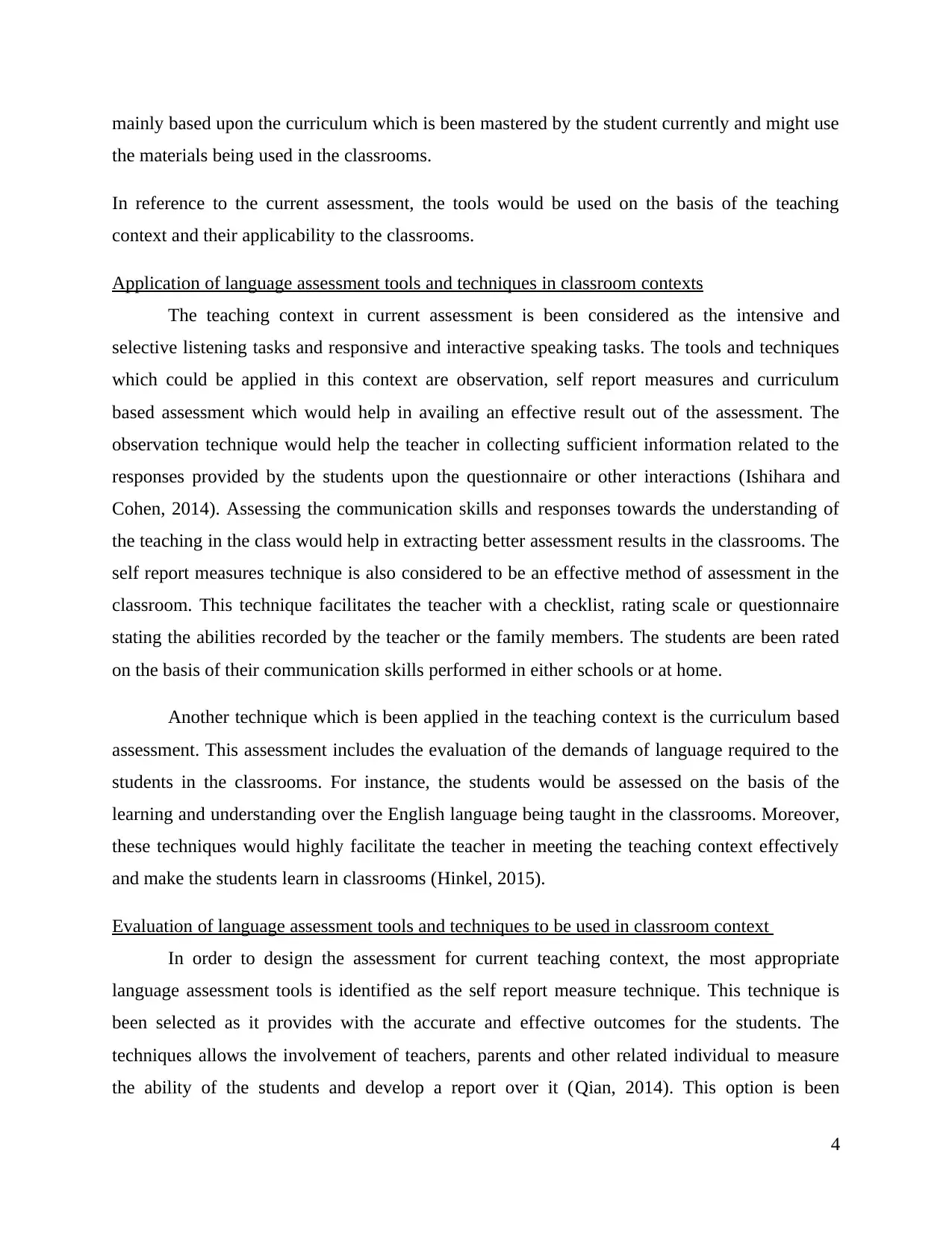
mainly based upon the curriculum which is been mastered by the student currently and might use
the materials being used in the classrooms.
In reference to the current assessment, the tools would be used on the basis of the teaching
context and their applicability to the classrooms.
Application of language assessment tools and techniques in classroom contexts
The teaching context in current assessment is been considered as the intensive and
selective listening tasks and responsive and interactive speaking tasks. The tools and techniques
which could be applied in this context are observation, self report measures and curriculum
based assessment which would help in availing an effective result out of the assessment. The
observation technique would help the teacher in collecting sufficient information related to the
responses provided by the students upon the questionnaire or other interactions (Ishihara and
Cohen, 2014). Assessing the communication skills and responses towards the understanding of
the teaching in the class would help in extracting better assessment results in the classrooms. The
self report measures technique is also considered to be an effective method of assessment in the
classroom. This technique facilitates the teacher with a checklist, rating scale or questionnaire
stating the abilities recorded by the teacher or the family members. The students are been rated
on the basis of their communication skills performed in either schools or at home.
Another technique which is been applied in the teaching context is the curriculum based
assessment. This assessment includes the evaluation of the demands of language required to the
students in the classrooms. For instance, the students would be assessed on the basis of the
learning and understanding over the English language being taught in the classrooms. Moreover,
these techniques would highly facilitate the teacher in meeting the teaching context effectively
and make the students learn in classrooms (Hinkel, 2015).
Evaluation of language assessment tools and techniques to be used in classroom context
In order to design the assessment for current teaching context, the most appropriate
language assessment tools is identified as the self report measure technique. This technique is
been selected as it provides with the accurate and effective outcomes for the students. The
techniques allows the involvement of teachers, parents and other related individual to measure
the ability of the students and develop a report over it (Qian, 2014). This option is been
4
the materials being used in the classrooms.
In reference to the current assessment, the tools would be used on the basis of the teaching
context and their applicability to the classrooms.
Application of language assessment tools and techniques in classroom contexts
The teaching context in current assessment is been considered as the intensive and
selective listening tasks and responsive and interactive speaking tasks. The tools and techniques
which could be applied in this context are observation, self report measures and curriculum
based assessment which would help in availing an effective result out of the assessment. The
observation technique would help the teacher in collecting sufficient information related to the
responses provided by the students upon the questionnaire or other interactions (Ishihara and
Cohen, 2014). Assessing the communication skills and responses towards the understanding of
the teaching in the class would help in extracting better assessment results in the classrooms. The
self report measures technique is also considered to be an effective method of assessment in the
classroom. This technique facilitates the teacher with a checklist, rating scale or questionnaire
stating the abilities recorded by the teacher or the family members. The students are been rated
on the basis of their communication skills performed in either schools or at home.
Another technique which is been applied in the teaching context is the curriculum based
assessment. This assessment includes the evaluation of the demands of language required to the
students in the classrooms. For instance, the students would be assessed on the basis of the
learning and understanding over the English language being taught in the classrooms. Moreover,
these techniques would highly facilitate the teacher in meeting the teaching context effectively
and make the students learn in classrooms (Hinkel, 2015).
Evaluation of language assessment tools and techniques to be used in classroom context
In order to design the assessment for current teaching context, the most appropriate
language assessment tools is identified as the self report measure technique. This technique is
been selected as it provides with the accurate and effective outcomes for the students. The
techniques allows the involvement of teachers, parents and other related individual to measure
the ability of the students and develop a report over it (Qian, 2014). This option is been
4
⊘ This is a preview!⊘
Do you want full access?
Subscribe today to unlock all pages.

Trusted by 1+ million students worldwide
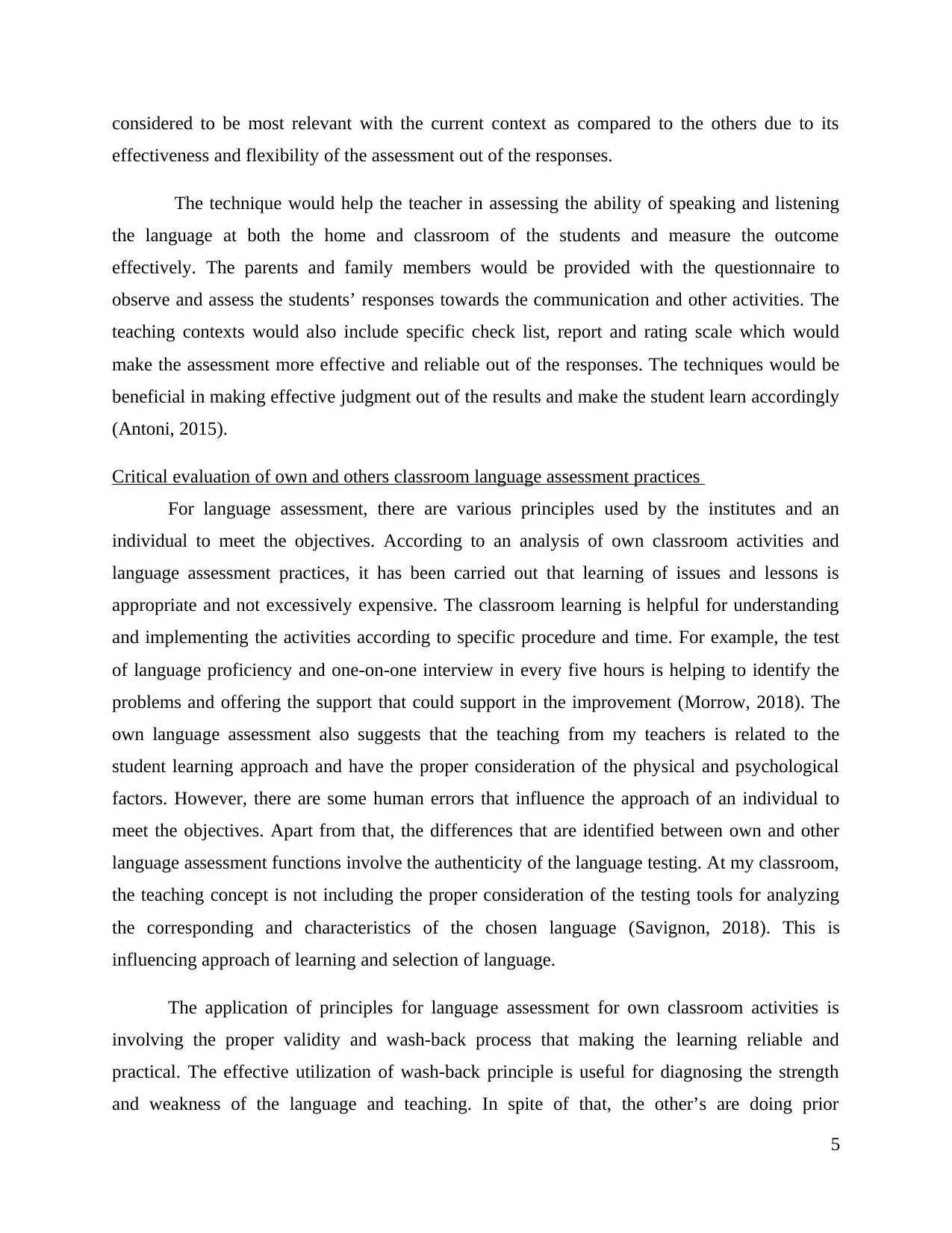
considered to be most relevant with the current context as compared to the others due to its
effectiveness and flexibility of the assessment out of the responses.
The technique would help the teacher in assessing the ability of speaking and listening
the language at both the home and classroom of the students and measure the outcome
effectively. The parents and family members would be provided with the questionnaire to
observe and assess the students’ responses towards the communication and other activities. The
teaching contexts would also include specific check list, report and rating scale which would
make the assessment more effective and reliable out of the responses. The techniques would be
beneficial in making effective judgment out of the results and make the student learn accordingly
(Antoni, 2015).
Critical evaluation of own and others classroom language assessment practices
For language assessment, there are various principles used by the institutes and an
individual to meet the objectives. According to an analysis of own classroom activities and
language assessment practices, it has been carried out that learning of issues and lessons is
appropriate and not excessively expensive. The classroom learning is helpful for understanding
and implementing the activities according to specific procedure and time. For example, the test
of language proficiency and one-on-one interview in every five hours is helping to identify the
problems and offering the support that could support in the improvement (Morrow, 2018). The
own language assessment also suggests that the teaching from my teachers is related to the
student learning approach and have the proper consideration of the physical and psychological
factors. However, there are some human errors that influence the approach of an individual to
meet the objectives. Apart from that, the differences that are identified between own and other
language assessment functions involve the authenticity of the language testing. At my classroom,
the teaching concept is not including the proper consideration of the testing tools for analyzing
the corresponding and characteristics of the chosen language (Savignon, 2018). This is
influencing approach of learning and selection of language.
The application of principles for language assessment for own classroom activities is
involving the proper validity and wash-back process that making the learning reliable and
practical. The effective utilization of wash-back principle is useful for diagnosing the strength
and weakness of the language and teaching. In spite of that, the other’s are doing prior
5
effectiveness and flexibility of the assessment out of the responses.
The technique would help the teacher in assessing the ability of speaking and listening
the language at both the home and classroom of the students and measure the outcome
effectively. The parents and family members would be provided with the questionnaire to
observe and assess the students’ responses towards the communication and other activities. The
teaching contexts would also include specific check list, report and rating scale which would
make the assessment more effective and reliable out of the responses. The techniques would be
beneficial in making effective judgment out of the results and make the student learn accordingly
(Antoni, 2015).
Critical evaluation of own and others classroom language assessment practices
For language assessment, there are various principles used by the institutes and an
individual to meet the objectives. According to an analysis of own classroom activities and
language assessment practices, it has been carried out that learning of issues and lessons is
appropriate and not excessively expensive. The classroom learning is helpful for understanding
and implementing the activities according to specific procedure and time. For example, the test
of language proficiency and one-on-one interview in every five hours is helping to identify the
problems and offering the support that could support in the improvement (Morrow, 2018). The
own language assessment also suggests that the teaching from my teachers is related to the
student learning approach and have the proper consideration of the physical and psychological
factors. However, there are some human errors that influence the approach of an individual to
meet the objectives. Apart from that, the differences that are identified between own and other
language assessment functions involve the authenticity of the language testing. At my classroom,
the teaching concept is not including the proper consideration of the testing tools for analyzing
the corresponding and characteristics of the chosen language (Savignon, 2018). This is
influencing approach of learning and selection of language.
The application of principles for language assessment for own classroom activities is
involving the proper validity and wash-back process that making the learning reliable and
practical. The effective utilization of wash-back principle is useful for diagnosing the strength
and weakness of the language and teaching. In spite of that, the other’s are doing prior
5
Paraphrase This Document
Need a fresh take? Get an instant paraphrase of this document with our AI Paraphraser
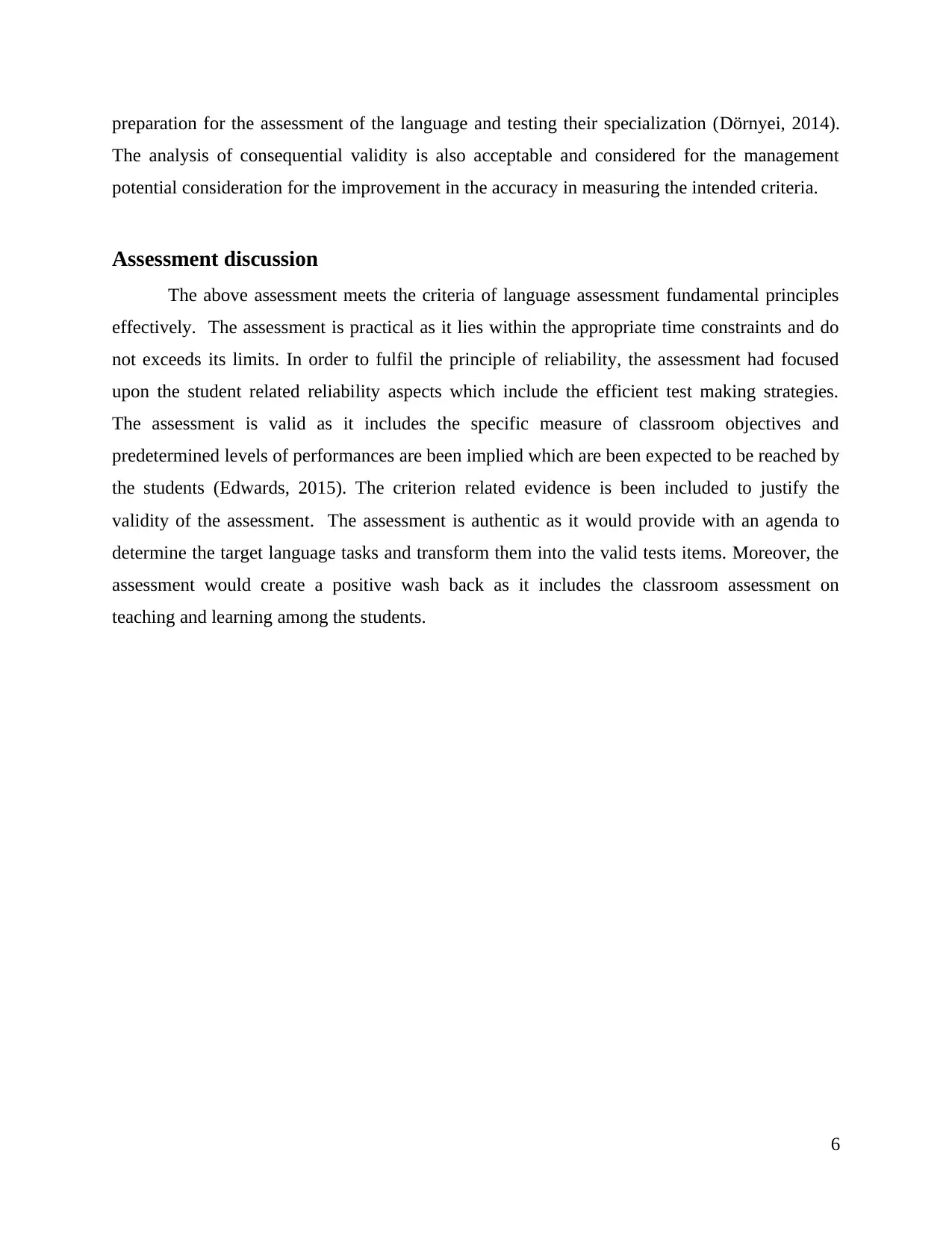
preparation for the assessment of the language and testing their specialization (Dörnyei, 2014).
The analysis of consequential validity is also acceptable and considered for the management
potential consideration for the improvement in the accuracy in measuring the intended criteria.
Assessment discussion
The above assessment meets the criteria of language assessment fundamental principles
effectively. The assessment is practical as it lies within the appropriate time constraints and do
not exceeds its limits. In order to fulfil the principle of reliability, the assessment had focused
upon the student related reliability aspects which include the efficient test making strategies.
The assessment is valid as it includes the specific measure of classroom objectives and
predetermined levels of performances are been implied which are been expected to be reached by
the students (Edwards, 2015). The criterion related evidence is been included to justify the
validity of the assessment. The assessment is authentic as it would provide with an agenda to
determine the target language tasks and transform them into the valid tests items. Moreover, the
assessment would create a positive wash back as it includes the classroom assessment on
teaching and learning among the students.
6
The analysis of consequential validity is also acceptable and considered for the management
potential consideration for the improvement in the accuracy in measuring the intended criteria.
Assessment discussion
The above assessment meets the criteria of language assessment fundamental principles
effectively. The assessment is practical as it lies within the appropriate time constraints and do
not exceeds its limits. In order to fulfil the principle of reliability, the assessment had focused
upon the student related reliability aspects which include the efficient test making strategies.
The assessment is valid as it includes the specific measure of classroom objectives and
predetermined levels of performances are been implied which are been expected to be reached by
the students (Edwards, 2015). The criterion related evidence is been included to justify the
validity of the assessment. The assessment is authentic as it would provide with an agenda to
determine the target language tasks and transform them into the valid tests items. Moreover, the
assessment would create a positive wash back as it includes the classroom assessment on
teaching and learning among the students.
6
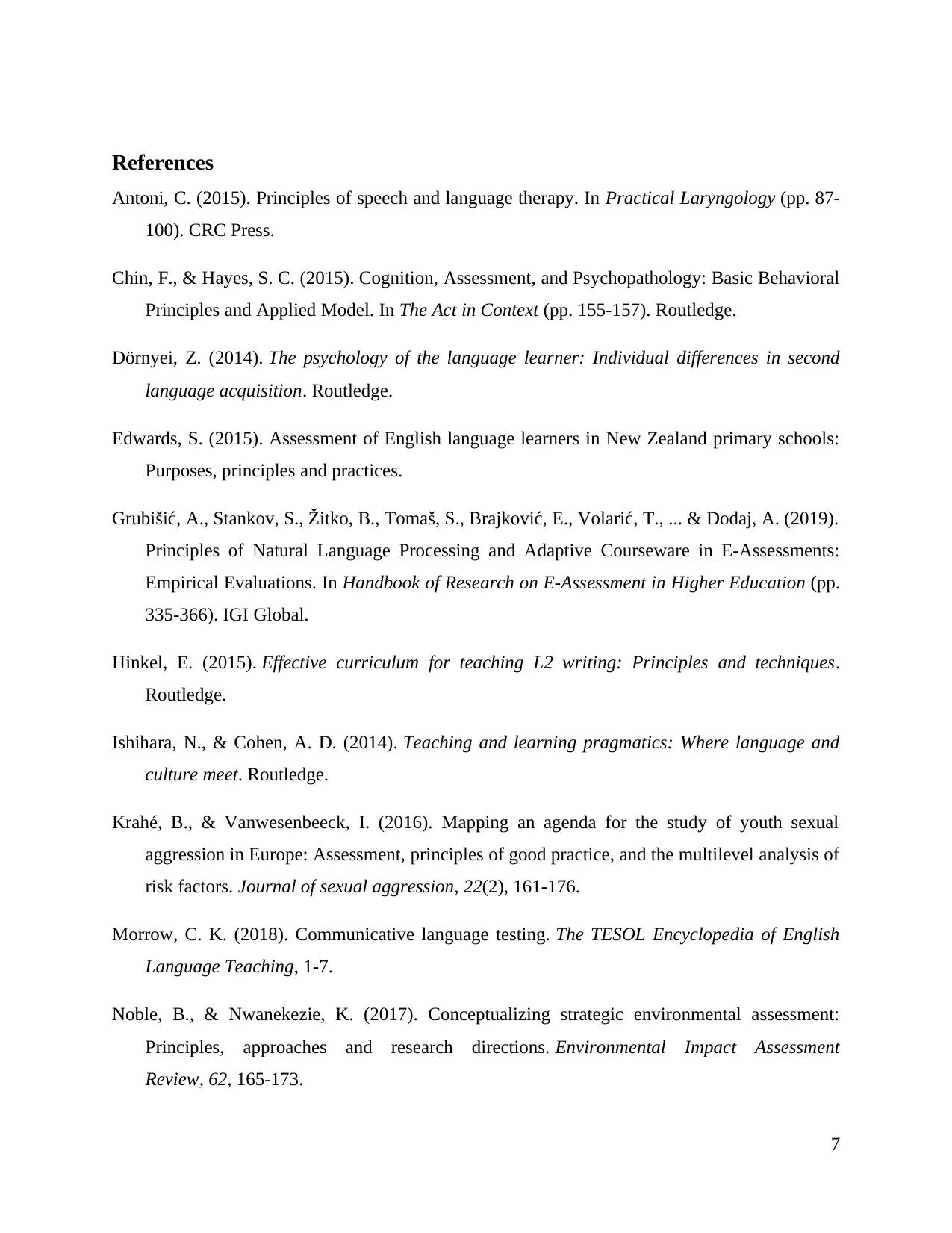
References
Antoni, C. (2015). Principles of speech and language therapy. In Practical Laryngology (pp. 87-
100). CRC Press.
Chin, F., & Hayes, S. C. (2015). Cognition, Assessment, and Psychopathology: Basic Behavioral
Principles and Applied Model. In The Act in Context (pp. 155-157). Routledge.
Dörnyei, Z. (2014). The psychology of the language learner: Individual differences in second
language acquisition. Routledge.
Edwards, S. (2015). Assessment of English language learners in New Zealand primary schools:
Purposes, principles and practices.
Grubišić, A., Stankov, S., Žitko, B., Tomaš, S., Brajković, E., Volarić, T., ... & Dodaj, A. (2019).
Principles of Natural Language Processing and Adaptive Courseware in E-Assessments:
Empirical Evaluations. In Handbook of Research on E-Assessment in Higher Education (pp.
335-366). IGI Global.
Hinkel, E. (2015). Effective curriculum for teaching L2 writing: Principles and techniques.
Routledge.
Ishihara, N., & Cohen, A. D. (2014). Teaching and learning pragmatics: Where language and
culture meet. Routledge.
Krahé, B., & Vanwesenbeeck, I. (2016). Mapping an agenda for the study of youth sexual
aggression in Europe: Assessment, principles of good practice, and the multilevel analysis of
risk factors. Journal of sexual aggression, 22(2), 161-176.
Morrow, C. K. (2018). Communicative language testing. The TESOL Encyclopedia of English
Language Teaching, 1-7.
Noble, B., & Nwanekezie, K. (2017). Conceptualizing strategic environmental assessment:
Principles, approaches and research directions. Environmental Impact Assessment
Review, 62, 165-173.
7
Antoni, C. (2015). Principles of speech and language therapy. In Practical Laryngology (pp. 87-
100). CRC Press.
Chin, F., & Hayes, S. C. (2015). Cognition, Assessment, and Psychopathology: Basic Behavioral
Principles and Applied Model. In The Act in Context (pp. 155-157). Routledge.
Dörnyei, Z. (2014). The psychology of the language learner: Individual differences in second
language acquisition. Routledge.
Edwards, S. (2015). Assessment of English language learners in New Zealand primary schools:
Purposes, principles and practices.
Grubišić, A., Stankov, S., Žitko, B., Tomaš, S., Brajković, E., Volarić, T., ... & Dodaj, A. (2019).
Principles of Natural Language Processing and Adaptive Courseware in E-Assessments:
Empirical Evaluations. In Handbook of Research on E-Assessment in Higher Education (pp.
335-366). IGI Global.
Hinkel, E. (2015). Effective curriculum for teaching L2 writing: Principles and techniques.
Routledge.
Ishihara, N., & Cohen, A. D. (2014). Teaching and learning pragmatics: Where language and
culture meet. Routledge.
Krahé, B., & Vanwesenbeeck, I. (2016). Mapping an agenda for the study of youth sexual
aggression in Europe: Assessment, principles of good practice, and the multilevel analysis of
risk factors. Journal of sexual aggression, 22(2), 161-176.
Morrow, C. K. (2018). Communicative language testing. The TESOL Encyclopedia of English
Language Teaching, 1-7.
Noble, B., & Nwanekezie, K. (2017). Conceptualizing strategic environmental assessment:
Principles, approaches and research directions. Environmental Impact Assessment
Review, 62, 165-173.
7
⊘ This is a preview!⊘
Do you want full access?
Subscribe today to unlock all pages.

Trusted by 1+ million students worldwide
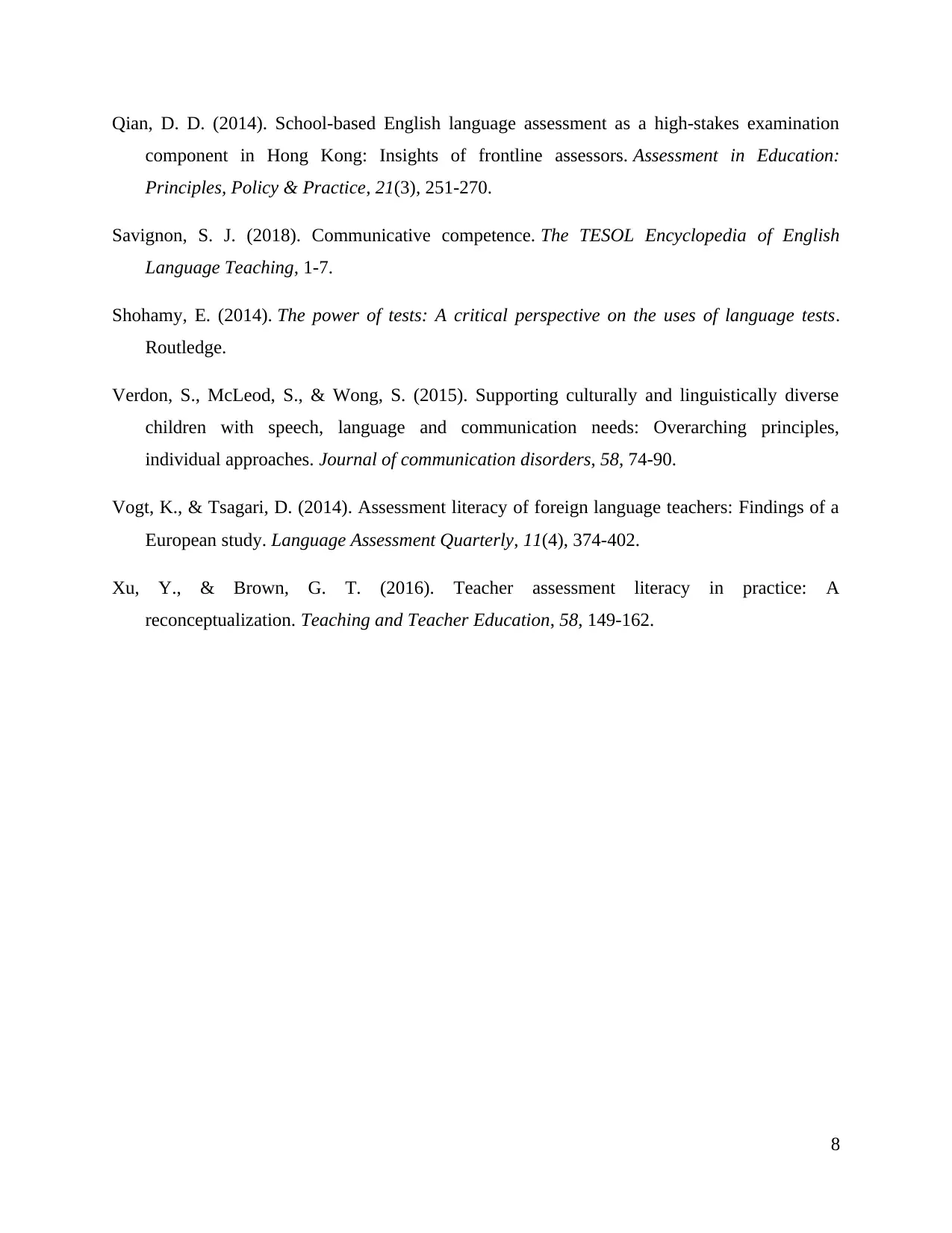
Qian, D. D. (2014). School-based English language assessment as a high-stakes examination
component in Hong Kong: Insights of frontline assessors. Assessment in Education:
Principles, Policy & Practice, 21(3), 251-270.
Savignon, S. J. (2018). Communicative competence. The TESOL Encyclopedia of English
Language Teaching, 1-7.
Shohamy, E. (2014). The power of tests: A critical perspective on the uses of language tests.
Routledge.
Verdon, S., McLeod, S., & Wong, S. (2015). Supporting culturally and linguistically diverse
children with speech, language and communication needs: Overarching principles,
individual approaches. Journal of communication disorders, 58, 74-90.
Vogt, K., & Tsagari, D. (2014). Assessment literacy of foreign language teachers: Findings of a
European study. Language Assessment Quarterly, 11(4), 374-402.
Xu, Y., & Brown, G. T. (2016). Teacher assessment literacy in practice: A
reconceptualization. Teaching and Teacher Education, 58, 149-162.
8
component in Hong Kong: Insights of frontline assessors. Assessment in Education:
Principles, Policy & Practice, 21(3), 251-270.
Savignon, S. J. (2018). Communicative competence. The TESOL Encyclopedia of English
Language Teaching, 1-7.
Shohamy, E. (2014). The power of tests: A critical perspective on the uses of language tests.
Routledge.
Verdon, S., McLeod, S., & Wong, S. (2015). Supporting culturally and linguistically diverse
children with speech, language and communication needs: Overarching principles,
individual approaches. Journal of communication disorders, 58, 74-90.
Vogt, K., & Tsagari, D. (2014). Assessment literacy of foreign language teachers: Findings of a
European study. Language Assessment Quarterly, 11(4), 374-402.
Xu, Y., & Brown, G. T. (2016). Teacher assessment literacy in practice: A
reconceptualization. Teaching and Teacher Education, 58, 149-162.
8
1 out of 10
Related Documents
Your All-in-One AI-Powered Toolkit for Academic Success.
+13062052269
info@desklib.com
Available 24*7 on WhatsApp / Email
![[object Object]](/_next/static/media/star-bottom.7253800d.svg)
Unlock your academic potential
Copyright © 2020–2025 A2Z Services. All Rights Reserved. Developed and managed by ZUCOL.





